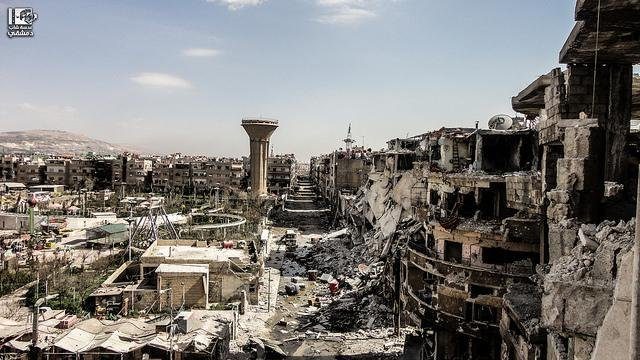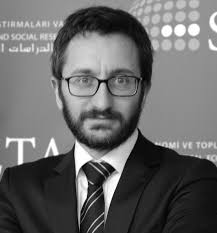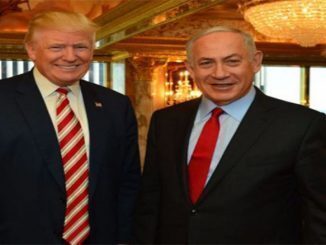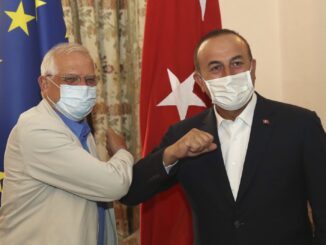
Hundreds of people left the besieged towns of Khan al-Shih and al-Tal southwest of Damascus on Monday under a deal with the Assad regime, after many previous similar deals were made in rural Damascus making the rebels lose important parts of their stronghold in the area and giving signs that all of it may fall soon.
By the summer of 2015, President Assad seemed on the verge of being overthrown. Then Russia launched its military intervention – all the while paying lip service to a diplomatic process the US administration pursued to no avail.
The Russian intervention tilted the war in favor of Assad regime and cost the rebels many of their strongholds, making Aleppo and rural Damascus among the last ones and the most important pressure point on Assad regime to accept a political solution to end the war.
Rebel groups retain a significant pocket of territory in Eastern Ghouta, an area of towns and farms east of the capital, but the enclave has been shrinking under army advances, intense bombing and a prolonged siege.
Assad regime forces, helped by Russian air power and Iran-backed Shiite militias, has steadily ended armed opposition influence in the remaining pockets of resistance around the capital using a series of army offensives and evacuation agreements, after years of siege, starvation and daily bombing.
Damascus describes the evacuation deals as “reconciliation” or “settlement agreements”, but rebels say they involve the forcible displacement of whole communities from opposition areas after years of siege and bombardment.
The Syrian Observatory for Human Rights, which monitors the civil war, said 10 buses had left Khan al-Shih for rebel-held Idlib province, but that it was unclear if they were carrying fighters themselves or only their families.
As part of the deal, around 1,450 rebels and 1,400 relatives are due to leave the town, the British-based Observatory reported. The process will require 42 buses, in addition to nearly 25 ambulances for injured civilians and fighters, it said.
Local sources in Khan al-Shih told Reuters earlier that 3,000 people, half of them fighters, were expected to evacuate the suburb, most of them on Monday.
The United Nations estimates 12,000 people have been besieged in Khan al-Shih, where a Palestinian refugee camp is located, for years. Heavy clashes and air strikes have rocked the area during the past month until the evacuation deal was agreed last week.
Syrian state-run Ikhbariya TV, broadcasting from near Khan al-Shih on Sunday, said 3,000 to 4,500 remaining people would be taken back into government-controlled areas, citing sources within the local administration.
The Observatory said also that around 2,000 rebels and family members had left al-Tal on Friday in more than 40 buses and some ambulances.
Syrian state television put the number at nearly 1,000, including fighters and their family members.
Those leaving will travel to northern Syria, local sources and the Observatory said
Syria’s Minister of National Reconciliation Affairs, Ali Haidar, whose department administers the agreements, could not immediately be reached for comment. Haidar has previously said such amnesties are “a workable model to bring security and peace” after more than five years of war.
Changing the demographics of Damascus
The Ghouta area is composed of densely populated suburbs to the east and south of Damascus, part of the province of rural Damascus.
Ghouta is a primarily conservative Sunni region. Since early in the crisis, civilians in rebel-held Eastern Ghouta have almost entirely sided with the opposition to Syria’s government. The opposition has controlled much of Eastern Ghouta since 2012, partly cutting off Damascus from the countryside.
In several Syrian areas, lengthy government sieges have prompted rebels to agree to evacuation deals, leading activists to accuse Damascus of using “starve or surrender” tactics.
Some opposition groups have criticized these preconditions, calling them a major setback as Sunnis would be forced from their homes, further fracturing the country along sectarian lines.
They are seen as part of a pattern in which the government pushes out Sunni communities that have been living there for decades. In 2015, one of the first deals was made in Zabadani on the outskirts of the capital.
In 2015, one of the first deals was made in Zabadani on the outskirts of the capital, and its citizens were displaced to other areas.
since then, Assad regime forces have pushed harder to achieve similar “victories” in the opposition-held pockets around the capital.
The most important losses were in Darayya and Mouadamiya towns, which have been under crippling siege since 2012.
The towns became known as a center for the opposition from the start of the uprising against Assad, and later an important stronghold for the rebels in rural Damascus.
Darayya surrender agreement was signed at the end of August 2016. For four years, Darayya was under daily attacks by Assad regime. Assad regime forces tried to take the city on the ground while Assad regime’s air force bombed the city daily.
Weeks of intense bombardment, which activists say included napalm attacks, has finally overwhelmed the rebels and forces them to sign surrender, while the world stands watching the civilians being displaced.
“Darayya did not fail today,” George Sabra, one of the political opposition members, said. “It was the international community who failed, and failed the people of Darayya.”
“For four years Darayya was under siege and the international community did nothing,” said an activist. “Four years and the United Nations couldn’t provide any humanitarian aid, except once.”
After nearly a week, rebels in Mouadamiya town also signed a similar agreement, giving Assad regime full control over the area again.
“It wasn’t a negotiation or a conversation, it was a threat,” an activist said. “They basically told us: ‘Either surrender or we burn Mouadamiya.”
“A large portion of people don’t want to leave their homes because they don’t want the regime to forcefully change the demography of the area. They want to clear the area and put a different sect here. That’s their plan,” activists added.
The surrender is a disaster first and foremost for the people of Darayya and Mouadamiya. According to the surrender agreement, the town’s fighters will be transferred to Idlib province and the civilians to other parts of rural Damascus. It means the final end of their community, therefore, and another ethnic cleansing.
Russian and Iranian propaganda machine is hard at work alongside the Syrian regime’s, trying to frame these events as the “liberation” of a population described as hostages of Islamic terrorists.
The west didn’t act as it should, to prevent these tragic incidents. Many ceasefire agreements accompanied by peace talks meetings were organized to help find a solution to the crisis, but Assad regime and its backers breached every ceasefire and hindered every peace talks meeting without any pressure moves or real steps from the western powers.
All the west could do was condemnations, calls to stop, and finally acting as if they were not involved.



